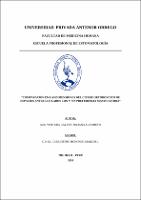Mostrar el registro sencillo del ítem
Comparación en las dimensiones del cierre ortodoncico de espacios entre los lados con y sin preferencia masticatoria
| dc.contributor.advisor | Carruitero Honores, Marcos J. | |
| dc.contributor.author | Ventura Galvez, Juliana Elizabeth | |
| dc.creator | Ventura Galvez, Juliana Elizabeth | |
| dc.date.accessioned | 2018-03-01T15:30:51Z | |
| dc.date.available | 2018-03-01T15:30:51Z | |
| dc.date.issued | 2018 | |
| dc.identifier | T_ESTO_502 | |
| dc.identifier.uri | https://hdl.handle.net/20.500.12759/3777 | |
| dc.description.abstract | Comparar la dimensión del cierre ortodoncico de espacio entre los lados con y sin preferencia masticatoria. Materiales y método: Se realizó un estudio observacional, ambispectivo, longitudinal y comparativo. Se evaluó a 174 pacientes. Se utilizó compás de punta seca y papel milimetrado para medir el cierre de espacio y goma de mascar para determinar el lado de preferencia masticatoria. El estudio piloto se realizó con 06 pacientes, empleando la prueba Coeficiente de Correlación de Intraclase, obteniendo valores superiores a 0.8. En modelos de diagnóstico del paciente se tomó medida al primer premolar en cada cuadrante, luego se tomaron nuevos modelos y se midió el espacio dejado por dicho premolar. Los datos recolectados se procesaron en el programa estadístico SPSS Statistics 22.0 (IBM, Armonk NY, USA), para luego presentar los resultados en tablas de doble entrada y/o gráficos. Resultados: Los resultados mostraron diferencias estadísticas altamente significativas (p<0.01). Hubo mayor reducción del cierre de espacio para el lado de no preferencia (3.80 +/-3.20) en comparación al lado de preferencia masticatoria (4.15 +/-3.60). Conclusiones: Se concluyó que existe mayor reducción del cierre ortodoncico de espacio para el lado de no preferencia en comparación al lado de preferencia masticatoria. | es_PE |
| dc.description.abstract | To compare the dimension of orthodontic closure of space between the sides with and without masticatory preference. Materials and methods: An observational, ambispective, longitudinal and comparative study was carried out. 174 patients were evaluated. We used dry-tip compass and graph paper to measure the space closure and chewing gum to determine the masticatory preference side. The pilot study was conducted with 06 patients, using the Intraclass Correlation Coefficient test, obtaining values higher than 0.8. In patient diagnosis models, the first premolar was measured in each quadrant, then new models were taken and the space left by said premolar was measured. The data collected were processed in the statistical program SPSS Statistics 22.0 (IBM, Armonk NY, USA), to then present the results in tables of double entry and / or graphics. Results: The results showed highly significant statistical differences (p <0.01). There was greater reduction of space closure for the non-preference side (3.80 +/- 3.20) compared to the masticatory preference side (4.15 +/- 3.60). Conclusions: It was concluded that there is a greater reduction of orthodontic space closure for the non-preference side compared to the masticatory preference side. | en_US |
| dc.format | application/pdf | es_PE |
| dc.language.iso | spa | es_PE |
| dc.publisher | Universidad Privada Antenor Orrego | es_PE |
| dc.relation.ispartofseries | T_ESTO_502 | |
| dc.rights | info:eu-repo/semantics/openAccess | es_PE |
| dc.source | Universidad Privada Antenor Orrego | es_PE |
| dc.source | Repositorio institucional - UPAO | es_PE |
| dc.subject | Cierre de Espacio | es_PE |
| dc.subject | Lado de Preferencia | es_PE |
| dc.title | Comparación en las dimensiones del cierre ortodoncico de espacios entre los lados con y sin preferencia masticatoria | es_PE |
| dc.type | info:eu-repo/semantics/bachelorThesis | es_PE |
| thesis.degree.level | Título Profesional | es_PE |
| thesis.degree.grantor | Universidad Privada Antenor Orrego. Facultad de Medicina Humana | es_PE |
| thesis.degree.name | Cirujano Dentista | es_PE |
| thesis.degree.discipline | Estomatología | es_PE |
Ficheros en el ítem
Este ítem aparece en la(s) siguiente(s) colección(es)
-
Estomatología [567]

